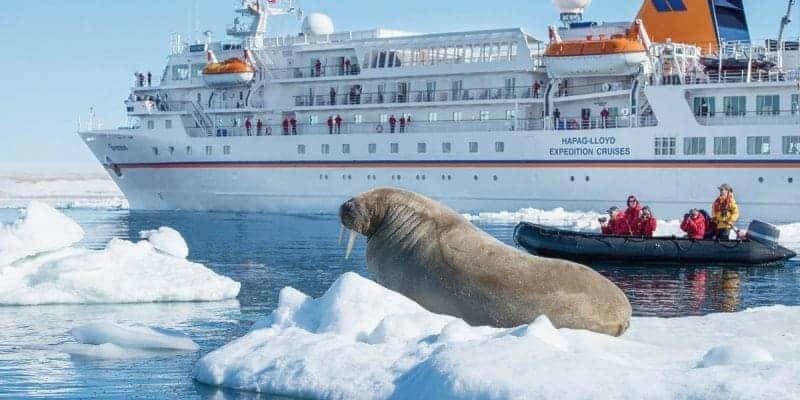As melting sea ice in the Arctic draws more cruise lines to offer Arctic voyages and the eyes of shipping companies hoping to cut down on the time goods move from port to port, experts are working to establish safe corridors to minimize the impact increased ocean traffic could have on the Arctic.
During the June 15-16 Arctic Development Expo, a panel discussion on shipping corridors in the Arctic highlighted several major areas of focus for marine planners in the north.
Inuvialuit Settlement Region Marine Program coordinator Tess Forbes gave an overview of the IRC’s forthcoming cruise ship management plan.
“This is a living document, it’s going to change as the cruise industry changes,” said Forbes. “Cruise ship tourism is an exciting opportunity for Inuvialuit. We need to balance economics with cultural and environmental protection.”
Cruise ships have been sailing the Arctic since at least 2005, but mostly in Greenland and Svalbard. Being late to the game could work to Canada’s advantage, suggested Forbes, because Canada had a unique opportunity to be proactive in how it regulates cruise lines.
In the ISR, the chief destination for cruise ships is Ulukhaktok. Since Canada has put a freeze on cruise ships stopping in the Canadian Arctic to prevent the spread of Covid-19, the most recent data available is from 2019. In that year, four ships carrying a total of 1,434 passengers brought $102,283.30 in sales, tourism activities and administration fees, which is a lot for a community of roughly 300 people.
Forbes said the IRC’s policy was put together with a focus on protecting the environment, preserving sensitive historical and cultural sites, engage in effective monitoring of participants, improve capacity for local economic development and maintain a balance between economic growth and environmental preservation.
To accomplish this, vessels and their passengers are under a code of conduct upon entering the Beaufort Sea, with an emphasis of employing Inuvialuit guides and not disturbing traditional harvests. Ships will be directed to low impact shipping corridors through the island chains for both the safety of the ships and the environment. Shipping routes will be reviewed by individual Hunting and Trapping Committees as well as Community Corporations.
“We would like to see the cruise ships stay within these pre-charted areas,” said Forbes. “We don’t have a lot of search and rescue capabilities up here and pro-active is always better than reactive.”
Cruise ships will also be forbidden from dumping on-board water, be that grey water, wastewater, bilge water or garbage, because the nutrients in the on-board water could lead to algae-blooms.
Tourism companies are also expected to reach out to communities they plan to visit to coordinate in advance.
Marine Transportation a deep issue
The panel discussion highlighted the many aspects of safe ocean transport and the environmental impacts of shipping, which don’t end on the shoreline.
“Shipping and maritime corridors are more than just the vessels that are navigating them,” said international trade specialist Alyson Azzara. “We have port and shore-side infrastructure requirements. Those requirements include energy and refuelling infrastructure, and those also will need to transition to continue to support economic development in the maritime.”
Factoring in the realities of climate change in on-shore infrastructure is important, noted Azzara, because with increased shipping will come more docks, piers and harbours to ensure the routes being travelled are low impact.
A low-impact shipping corridor, explained Peter Oppenheimer of the Arctic Council, is an area that possesses one or more of several elements.
First and foremost is a low risk to the ship itself, preventing damage to the ship or the surrounding area from collisions. They typically are well mapped out to modern standards and have few obstacles to ships travelling through them and have up to date weather reports and projections for the operator of a ship.
Strong and open lines of communications with on-shore facilities and quick access to search and rescue are other elements of designated low impact corridors, as well as the effect a ship moving through an area could potentially have on hunting and subsistence practices by Indigenous groups living in the area.
Impacts of the ship and the noise it creates on the surrounding ecosystem are considered, as loud ship noises can have impacts on migrations, feeding habits and even kill the mood during some animals’ breeding season. Transport is also minimized through Marine Protected Areas.
Establishing those low-impact routes is easier said than done in the Arctic, explained Coast Guard regional director Joanne Weiss Reid. She noted that the Canadian Arctic’s 162,000 kilometre coastline presented very unique challenges in the search and rescue field, which is predicted to be increasingly essential as climate change related problems set in across the North. She also noted less than 10 per cent of the navigable waters in the North have been surveyed to modern standards.
She added the Coast Guard provides daily ice conditions and has eight ice breakers deployed in the Arctic this year, running from May to November. Work is underway on fleet modernization and the coast guard is also in the process of acquiring two new polar ice breakers coming online next year.
“These new polar ice breakers will extend the coast guard’s on water, Arctic operations to a year-round capacity in all areas of the Canadian Arctic,” she said. “(They) will enhance capacity for Arctic Science and Canada’s sovereignty in the north.”
A February joint-statement by Transport Canada and the United States department acknowledges transportation is one of the largest sources of greenhouse gas emissions on the planet and pledges to factor environmental considerations into all shipping and transport regulations.
